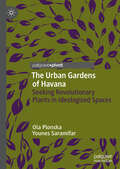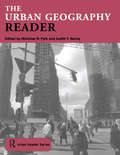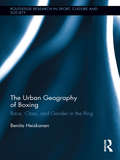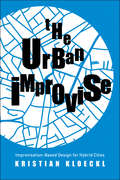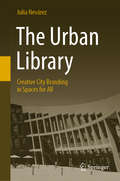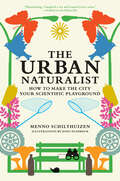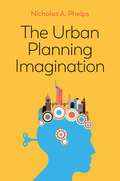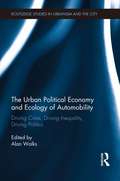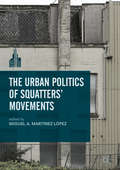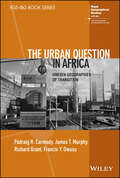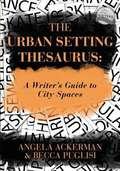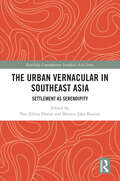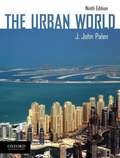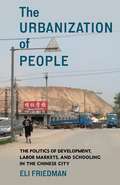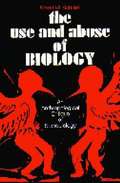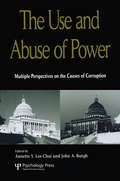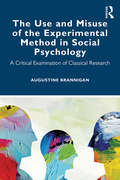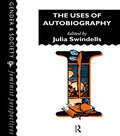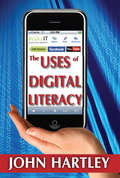- Table View
- List View
The Urban Gardens of Havana: Seeking Revolutionary Plants in Ideologized Spaces
by Ola Plonska Younes SaramifarThis book relates stories of everyday life revolving around small-scale urban gardens in Central Havana and focusing particularly on that of Marcelo, a seventy-four-year-old revolutionary and gardener. The urban gardens are contested spaces: though monitored and controlled by Cuban state institutions, they also offer possibilities of crafting life in resistance. The experiences the authors narrate are not ‘thick descriptions,’ linked to larger political issues, but rather rhizomatic observations that highlight the relationships between humans and non-humans within the nature-culture debate. Using these experiences, the authors argue that ‘the political’ reaches beyond the affairs of state and governance and should be seen as an all-encompassing part of life. The authors thereby invite the social sciences to focus on the microscopic and the day-to-day to illuminate how the political affairs of lives can be imagined differently.
The Urban Geography Reader (Routledge Urban Reader Series)
by Judith T. Kenny Nicholas R. FyfeDrawing on a rich diversity of theoretical approaches and analytical strategies, urban geographers have been at the forefront of understanding the global and local processes shaping cities, and of making sense of the urban experiences of a wide variety of social groups. Through their links with those working in the fields of urban policy design, urban geographers have also played an important role in the analysis of the economic and social problems confronting cities. Capturing the diversity of scholarship in the field of urban geography, this reader presents a stimulating selection of articles and excerpts by leading figures. Organized around seven themes, it addresses the changing economic, social, cultural, and technological conditions of contemporary urbanization and the range of personal and public responses. It reflects the academic importance of urban geography in terms of both its theoretical and empirical analysis as well as its applied policy relevance, and features extensive editorial input in the form of general, section and individual extract introductions. Bringing together in one volume 'classic' and contemporary pieces of urban geography, studies undertaken in the developed and developing worlds, and examples of theoretical and applied research, it provides in a convenient, student-friendly format, an unparalleled resource for those studying the complex geographies of urban areas.
The Urban Geography of Boxing: Race, Class, and Gender in the Ring (Routledge Research in Sport, Culture and Society)
by Benita HeiskanenThis book is an interdisciplinary cultural examination of twenty-first century boxing as a professional sport, a bodily labor, a lucrative business, a popular entertainment, and an instrument of ideology. Based on ethnographic fieldwork and interviews conducted with Latino boxers, women boxers, and boxing insiders in Texas, it discusses boxing from the vantage point of the sundry players, who are involved with it: the labor force, promoters, handlers, ringside officials, medical professionals, media, and the audiences. The various parties have multiple stakes in the sport. For some, boxing is about physical empowerment; others are in it for the money; some deploy it for ideological purposes; yet others use it to claim their 15-minutes of fame, and frequently the various interests overlap. In this book, Benita Heiskanen makes a broader connection between boxing and the spatial organization of racialized, class-based, and gendered bodies within particular urban geographies. Journeying actual sites where the sport is organized, such as the barrio, boxing gym, and competition venues, she maps the ways in which boxing insiders negotiate a variety of conflicting agendas at local, regional, and national scales. Beyond the United States, the worker-athletes conduct their labor within global socioeconomic conditions, business networks, and legal principles. Through this sporting context, Heiskanen’s discussion discloses some complex socio-historical, cultural, and political power relations between urban margins and centers, with ramifications far beyond boxing. This book will be of interest to readers in Sport Studies, Cultural Studies, Cultural Geography, Gender Studies, Critical Race Theory, Labor Studies, and American Studies.
The Urban Improvise: Improvisation-Based Design for Hybrid Cities
by Kristian KloecklA book for architects, designers, planners, and urbanites that explores how cities can embrace improvisation to improve urban life The built environment in today’s hybrid cities is changing radically. The pervasiveness of networked mobile and embedded devices has transformed a predominantly stable background for human activity into spaces that have a more fluid behavior. Based on their capability to sense, compute, and act in real time, urban spaces have the potential to go beyond planned behaviors and, instead, change and adapt dynamically. These interactions resemble improvisation in the performing arts, and this book offers a new improvisation-based framework for thinking about future cities. Kristian Kloeckl moves beyond the smart city concept by unlocking performativity, and specifically improvisation, as a new design approach and explores how city lights, buses, plazas, and other urban environments are capable of behavior beyond scripts. Drawing on research of digital cities and design theory, he makes improvisation useful and applicable to the condition of today’s technology-imbued cities and proposes a new future for responsive urban design.
The Urban Library: Creative City Branding in Spaces for All
by Julia NevárezThis book examines the role, history and function of public libraries in contemporary societies as motors that drive development. It analyses through case studies, how contemporary libraries have been redesigned to offer a new kind of public space while also reshaping neglected areas in cities. Broadly understood the book seeks to comprehend contemporary library design, urban development and the revitalization of specific urban areas.Important and world famous architects – star-architects – have designed signature architecture in the contemporary libraries selected for this volume. The examples to be showcased in the book include the main Seattle Public Library, Salt Lake City Public Library, New York Public Library, Spain Library Medellin, Colombia, Halifax Central Library Nova Scotia, Canada and Library of Alexandria in Egypt to offer examples of what constitute the approach to libraries and urban development in many cities around the world nowadays. Data in the form of interviews to library directors, librarians and users, tours of libraries, visual documentation and archival research have been collected for most public libraries included as case studies for the book.The impulse to archive has been framed and understood in the literature as a modern desire to control fleeting reality. Libraries as such respond to this desire by collecting, storing and circulating resources (books and other kinds of media). But more recently there has been an emphasis on the public character of library spaces in which people gather not only to obtain information and read by themselves but also to experience the very urban quality of proximity to others in more informal and less structured environments as public space. Community events characterize the programming of all the libraries included in the book. The design of these new libraries fit into urban development initiatives where libraries – like other iconic cultural spaces of cities – become central components to market cities for the consumption of culture. Libraries become sites to be visited and explored by tourists while providing services for residents. They are also machines to accelerate urban development especially in areas previously neglected by development.
The Urban Naturalist: How to Make the City Your Scientific Playground
by Menno SchilthuizenA manifesto—and a field guide—for a new dawn of natural history, practiced by community scientists in their own urban jungle.Imagine taking your smartphone-turned-microscope to an empty lot and discovering a rare mason bee that builds its nest in empty snail shells. Or a miniature spider that hunts ants and carries their corpses around. With a team of citizen scientists, that&’s exactly what Menno Schilthuizen did—one instance in the evolutionary biologist&’s campaign to take natural science to the urban landscape where most of us live today. In this delightful book, The Urban Naturalist, Schilthuizen invites us to join him, to embark on a new age of discovery, venturing out as intrepid explorers of our own urban habitat—and maybe in the process do the natural world some good.Thanks to the open science revolution, real biological discoveries can now be made by anyone right where they live. Schilthuizen shows readers just how to go about making those discoveries, introducing them to the tools of the trade of the urban community scientist, from the tried and tested (the field notebook, the butterfly net, and the hand lens) to the newfangled (internet resources, low-tech gadgets, and off-the-shelf gizmos). But beyond technology, his book holds the promise of reviving the lost tradition of the citizen scientist—rekindling the spirit of the Victorian naturalist for the modern world.At a time when the only nature most people get to see is urban, The Urban Naturalist demonstrates that understanding the novel ecosystems around us is our best hope for appreciating and protecting biodiversity.
The Urban Planning Imagination: A Critical International Introduction
by Nicholas A. PhelpsUrban planning is not just about applying a suite of systematic principles or plotting out pragmatic designs to satisfy the briefs of private developers or public bodies. Planning is also an activity of imagination, with a stock of wisdom and an array of useful methods for making decisions and getting things done. This critical introduction uncovers and celebrates this imagination and its creative potential. Nicholas A. Phelps explores the key themes and driving questions in the circulation of planning ideas and methods over time and across spaces, identifying the contrasts and commonalities between urban planning systems and cultures. He argues that the tools for inclusive urban planning are today, more than ever, not solely restricted to the hands of planning bodies, but are distributed across citizens, a variety of organizations (what Phelps calls ‘clubs’) and states. As a result, the book sets the ground for the new arrangements between these groups and actors which will be central to the future of urban planning. By unsettling standard accounts, this book compels us towards more critical and creative thinking to ensure that the imagination, wisdom and methods of urban planning are mobilized towards achieving the aspiration of shaping better places.
The Urban Political Economy and Ecology of Automobility: Driving Cities, Driving Inequality, Driving Politics (Routledge Studies in Urbanism and the City)
by Alan WalksJust how resilient are our urban societies to social, energy, environmental and/or financial shocks, and how does this vary among cities and nations? Can our cities be made more sustainable, and can environmental, economic and social collapse be staved off through changes in urban form and travel behaviour? How might rising indebtedness and the recent series of financial crises be related to automobile dependence and patterns of urban automobile use? To what extent does the system and economy of automobility factor in the production of urban socio-spatial inequalities, and how might these inequalities in mobility be understood and measured? What can we learn from the politics of mobility and social movements within cities? What is the role of automobility, and auto-dependence, in differentiating groups, both within cities and rural areas, and among transnational migrants moving across international borders? These are just some of the questions this book addresses. This volume provides a holistic and reflexive account of the role played by automobility in producing, reproducing, and differentiating social, economic and political life in the contemporary city, as well as the role played by the city in producing and reproducing auto-mobile inequalities. The first section, titled Driving Vulnerability, deals with issues of global importance related to economic, social, financial, and environmental sustainability and resilience, and socialization. The second section, Driving Inequality, is concerned with understanding the role played by automobility in producing urban socio-spatial inequalities, including those rooted in accessibility to work, migration status and ethnic concentration, and new measures of mobility-based inequality derived from the concept of effective speed. The third section, titled, Driving Politics, explores the politics of mobility in particular places, with an eye to demonstrating both the relevance of the politics of mobility for influencing and reinforcing actually existing neoliberalisms, and the kinds of politics that might allow for reform or restructuring of the auto-mobile city into one that is more socially, politically and environmentally just. In the conclusion to the book Walks draws on the findings of the other chapters to comment on the relationship between automobility, neoliberalism and citizenship, and to lay out strategies for dealing with the urban car system.
The Urban Politics of Squatters' Movements
by Miguel A. Martínez LópezThis volume sheds light on the development of squatting practices and movements in nine European cities (Madrid, Barcelona, Seville, Rome, Paris, Berlin, Copenhagen, Rotterdam and Brighton) by examining the numbers, variations and significant contexts in their life course. It reveals how and why squatting practices have shifted and to what extent they engender urban movements. The book measures the volume and changes in squatting over various decades, mostly by focusing on Squatted Social Centres but also including squatted housing. In addition, it systematically compares the cycles, socio-spatial structures and the political implications of squatting in selected cities. This collection highlights how squatters’ movements have persisted over more than four decades through different trajectories and circumstances, especially in relation to broader protest cycles and reveals how political opportunities and constraints influence the conflicts around the legalisation of squats.p>
The Urban Question in Africa: Uneven Geographies of Transition (RGS-IBG Book Series)
by Richard Grant James T. Murphy Padraig R. Carmody Francis Y. OwusuIlluminates the path to more generative urban transitions in Africa's cities and developing rural areas Africa is the world's most rapidly urbanizing region. The predominantly rural continent is currently undergoing an “urban revolution” unlike any other, generally taking place without industrialization and often characterized by polarization, poverty, and fragmentation. While many cities have experienced construction booms and real estate speculation, others are marked by expanding informal economies and imploding infrastructures. The Urban Question in Africa: Uneven Geographies of Transition examines the imbalanced and contested nature of the ongoing urban transition of Africa. Edited and authored by leading experts on the subject, this unique volume develops an original theory conceptualizing cities as sociotechnical systems constituted by production, consumption, and infrastructure regimes. Throughout the book, in-depth chapters address the impacts of current meta-trends—global geopolitical shifts, economic changes, the climate crisis, and others—on Africa's cities and the broader development of the continent. Presents a novel framework based on extensive fieldwork in multiple countries and regions of the continent Examines geopolitical and socioeconomic topics such as manufacturing in African cities, the green economy in Africa, and the impact of China on urban Africa Discusses the prospects for generative urbanism to produce and sustain long-term development in Africa Features high-quality maps, illustrations, and photographsThe Urban Question in Africa: Uneven Geographies of Transition is essential reading for undergraduate and postgraduate students in geography, urban planning, and African studies, academic researchers, geographers, urban planners, and policymakers.
The Urban Revolution
by Henri LefebvreOriginally published in 1970, The Urban Revolution marked Henri Lefebvre’s first sustained critique of urban society, a work in which he pioneered the use of semiotic, structuralist, and poststructuralist methodologies in analyzing the development of the urban environment. Although it is widely considered a foundational book in contemporary thinking about the city, The Urban Revolution has never been translated into English—until now. This first English edition, deftly translated by Robert Bononno, makes available to a broad audience Lefebvre’s sophisticated insights into the urban dimensions of modern life.Lefebvre begins with the premise that the total urbanization of society is an inevitable process that demands of its critics new interpretive and perceptual approaches that recognize the urban as a complex field of inquiry. Dismissive of cold, modernist visions of the city, particularly those embodied by rationalist architects and urban planners like Le Corbusier, Lefebvre instead articulates the lived experiences of individual inhabitants of the city. In contrast to the ideology of urbanism and its reliance on commodification and bureaucratization—the capitalist logic of market and state—Lefebvre conceives of an urban utopia characterized by self-determination, individual creativity, and authentic social relationships.A brilliantly conceived and theoretically rigorous investigation into the realities and possibilities of urban space, The Urban Revolution remains an essential analysis of and guide to the nature of the city.Henri Lefebvre (d. 1991) was one of the most significant European thinkers of the twentieth century. His many books include The Production of Space (1991), Everyday Life in the Modern World (1994), Introduction to Modernity (1995), and Writings on Cities (1995).Robert Bononno is a full-time translator who lives in New York. His recent translations include The Singular Objects of Architecture by Jean Baudrillard and Jean Nouvel (Minnesota, 2002) and Cyberculture by Pierre Lévy (Minnesota, 2001).
The Urban Setting Thesaurus: A Writer's Guide to City Spaces
by Angela Ackerman; Becca PuglisiMaking readers care and feel like they’re part of the story should be the number one goal for all writers. Ironically, many storytellers fail to maximize one of fiction’s most powerful elements to achieve this: the setting. Not only can the right location become a conduit for emotion, it can also provide conflict, characterize the story’s cast, reveal significant backstory, and trigger the reader’s own emotional memories through sensory details and deep point of view.
The Urban Uncanny: A collection of interdisciplinary studies
by Lucy HuskinsonThe Urban Uncanny explores through ten engaging essays the slippage or mismatch between our expectations of the city—as the organised and familiar environments in which citizens live, work, and go about their lives—and the often surprising and unsettling experiences it evokes. The city is uncanny when it reveals itself in new and unexpected light; when its streets, buildings, and people suddenly appear strange, out of place, and not quite right. Bringing together a variety of approaches, including psychoanalysis, historical and contemporary case study of cities, urban geography, film and literary critique, the essays explore some of the unsettling mismatches between city and citizen in order to make sense of each, and to gauge the wellbeing of city life more generally. Essays examine a number of cities, including Edmonton, London, Paris, Oxford, Las Vegas, Berlin and New York, and address a range of issues, including those of memory, death, anxiety, alienation, and identity. Delving into the complex repercussions of contemporary mass urban development, The Urban Uncanny opens up the pathological side of cities, both real and imaginary. This interdisciplinary collection provides unparalleled insights into the urban uncanny that will be of interest to academics and students of urban studies, urban geography, psychoanalysis, cultural studies, social studies and film studies, and to anyone interested in the darker side of city life.
The Urban Vernacular in Southeast Asia: Settlement as Serendipity (Routledge Contemporary Southeast Asia Series)
by Nor Zalina Harun and Shireen Jahn KassimThis book constructs a number of discourses, dialectics and analyses across the disciplines of urban form, architecture and urban experience, thus incorporating both conservation and design issues.It bridges the gap between practice and theory by reconstructing the role of the “village” or “vernacular” in the discourses and trends of the twenty-first century post-Covid19 environment. Bringing together for the first time the confluences of theory and practice in the “urban vernacular” and the “urban village,” the contributors use vernacular concepts and settings as a common framework serving as cultural bridges, connecting traditional forms, ecologies and habitats to new global ideas, industrial economies and access to developing urban sustainability, design, planning and services in Asia's rising megacities. The book begins with concerns of urban layout and morphology, aiming to establish discourse, shared principles and terminology around conventional ideas of the “village” or traditional settlements' apparently organic and disordered nature. It then moves into architectural dimensions, capturing formal cases of how the “vernacular” or traditional “indigenous” local concepts have inspired new ideas in award-winning architecture and hence the importance of re-examining the vernacular in light of the ongoing need to produce a more sustainable and place-conscious fit in modern architecture and urban planning.The book will be of interest to researchers in the fields of architecture, urban planning and design, urban geography, design studies, landscape architecture, history of architecture/urbanism and Asian Studies, in particular those concerning Southeast Asia.
The Urban World (Ninth Edition)
by J. John PalenThe Urban World provides a comprehensive, balanced, up-to-date, cross-cultural look at cities and suburbs around the world. Offering a 21st century view of the changing urban scene, the text covers evolving urban patterns and the changing nature of urban life.
The Urbanisation of Rome and Latium Vetus
by Francesca FulminanteThis book focuses on urbanization and state formation in middle Tyrrhenian Italy during the first millennium BC by analyzing settlement organization and territorial patterns in Rome and Latium vetus from the Bronze Age to the Archaic Era. In contrast with the traditional diffusionist view, which holds that the idea of the city was introduced to the West via Greek and Phoenician colonists from the more developed Near East, this book demonstrates important local developments towards higher complexity, dating to at least the beginning of the Early Iron Age, if not earlier. By adopting a multidisciplinary and multi-theoretical framework, this book overcomes the old debate between exogenous and endogenous by suggesting a network approach that sees Mediterranean urbanization as the product of reciprocal catalyzing actions.
The Urbanism of Exception
by Martin J. MurrayThis book challenges the conventional (modernist-inspired) understanding of urbanization as a universal process tied to the ideal-typical model of the modern metropolis with its origins in the grand Western experience of city-building. At the start of the twenty-first century, the familiar idea of the 'city' - or 'urbanism' as we know it - has experienced such profound mutations in both structure and form that the customary epistemological categories and prevailing conceptual frameworks that predominate in conventional urban theory are no longer capable of explaining the evolving patterns of city-making. Global urbanism has increasingly taken shape as vast, distended city-regions, where urbanizing landscapes are increasingly fragmented into discontinuous assemblages of enclosed enclaves characterized by global connectivity and concentrated wealth, on the one side, and distressed zones of neglect and impoverishment, on the other. These emergent patterns of what might be called enclave urbanism have gone hand-in-hand with the new modes of urban governance, where the crystallization of privatized regulatory regimes has effectively shielded wealthy enclaves from public oversight and interference.
The Urbanization of Green Internationalism (Cities and the Global Politics of the Environment)
by Yonn DierwechterThe recent rise of cities in global environmental politics has stimulated remarkable debates about sustainable urban development and the geopolitics of a changing world order no longer defined by tightly bordered national regimes. This book explores this major theme by drawing on approaches that document the diverse histories and emergent geographies of “internationalism.” It is no longer possible, the book argues, to analyze the global politics of the environment without considering its various urbanization(s), wherein multiple actors are reforming, reassembling and adapting to nascent threats posed by global ecological decay. The ongoing imposition and abrasion of different world orders—Westphalian and post-Westphalian—further suggests we need a wider frame to capture new kinds of urbanized spaces and global green politics. The book will appeal to students, scholars, and practitioners interested in global sustainability, urban development, planning, politics, and international affairs. Case studies and grounded examples of green internationalism in urban action ultimately explore how select city-regions like Cape Town, Los Angeles, and Melbourne are trying to negotiate and actually work through this postulated dilemma.
The Urbanization of People: The Politics of Development, Labor Markets, and Schooling in the Chinese City
by Eli FriedmanAmid a vast influx of rural migrants into urban areas, China has allowed cities wide latitude in providing education and other social services. While millions of people have been welcomed into the megacities as a source of cheap labor, local governments have used various tools to limit their access to full citizenship.The Urbanization of People reveals how cities in China have granted public goods to the privileged while condemning poor and working-class migrants to insecurity, constant mobility, and degraded educational opportunities. Using the school as a lens on urban life, Eli Friedman investigates how the state manages flows of people into the city. He demonstrates that urban governments are providing quality public education to those who need it least: school admissions for nonlocals heavily favor families with high levels of economic and cultural capital. Those deemed not useful are left to enroll their children in precarious resource-starved private schools that sometimes are subjected to forced demolition. Over time, these populations are shunted away to smaller locales with inferior public services.Based on extensive ethnographic research and hundreds of in-depth interviews, this interdisciplinary book details the policy framework that produces unequal outcomes as well as providing a fine-grained account of the life experiences of people drawn into the cities as workers but excluded as full citizens.
The Use and Abuse of Biology: An Anthropological Critique of Sociobiology
by Marshall SahlinsA criticism of sociobiology by one of the world's foremost anthropologists.
The Use and Abuse of Power
by John A. Bargh Annette Y. Lee-ChaiA compilation of works from prominent researchers, promoting both a panoramic and multilevel understanding of this complex construct, with focus on power as a cause of social ills and remedies to prevent corruption and abuse.
The Use and Misuse of the Experimental Method in Social Psychology: A Critical Examination of Classical Research
by Augustine BranniganThis book critically examines the work of a number of pioneers of social psychology, including legendary figures such as Kurt Lewin, Leon Festinger, Muzafer Sherif, Solomon Asch, Stanley Milgram, and Philip Zimbardo. Augustine Brannigan argues that the reliance of these psychologists on experimentation has led to questions around validity and replication of their studies. The author explores new research and archival work relating to these studies and outlines a new approach to experimentation that repudiates the use of deception in human experiments and provides clues to how social psychology can re-articulate its premises and future lines of research. Based on the author’s 2004 work The Rise and Fall of Social Psychology, in which he critiques the experimental methods used, the book advocates for a return to qualitative methods to redeem the essential social dimensions of social psychology. Covering famous studies such as the Stanford Prison Experiment, Milgram’s studies of obedience, Sherif's Robbers Cave, and Rosenhan's exposé of psychiatric institutions, this is essential and fascinating reading for students of social psychology, and the social sciences. It’s also of interest to academics and researchers interested in engaging with a critical approach to classical social psychology, with a view to changing the future of this important discipline.
The Uses Of Autobiography
by Julia SwindellsFirst Published in 1995. Routledge is an imprint of Taylor & Francis, an informa company.
The Uses of Digital Literacy (Creative Economy + Innovation Culture Ser.)
by John HartleyAt the heart of this book lies a reappraisal of humanities research and its use in understanding the conditions of a consumer-led society. This is an open, investigative, critical, scientific task as well as an opportunity to engage with creative enterprise and culture. Now that every user is a publisher, consumption needs to be rethought as action not behavior, and media consumption as a mode of literacy.Online social networks and participatory media are often still ignored by professionals, denounced in the press and banned in schools. But the potential of digital literacy should not be underestimated. Fifty years after Richard Hoggart's pioneering The Uses of Literacy reshaped the educational response to popular culture, John Hartley extends Hoggart's argument into digital media. Media evolution has made possible the realism of the modern age journalism, the novel and science not to mention mass entertainment on a global scale.Hartley reassesses the historical and global context, commercial and cultural dynamics and the potential of popular productivity through analysis of the use of digital media in various domains, including creative industries, digital storytelling, YouTube, journalism, and mediated fashion. Encouraging mass participation in the evolutionary growth of knowledge, The Uses of Digital Literacy shows how today's teenage fad may become tomorrow's scientific method. Hartley claims the time has come for education to catch up with entertainment and for the professionals to learn from popular culture. This book will stimulate the imagination and stir further research.
The Uses of Disorder: Personal Identity and City Life
by Richard Sennett"[Sennett] has ended up writing the best available contemporary defense of anarchism. . . . The issues [he] raises are fundamental and profound. His book is utopian in the best sense--it tries to define a radically different future and to show that it could be constructed from the materials at hand." -Kenneth Keniston, New York Times Book Review The distinguished social critic Richard Sennett here shows how the excessively ordered community freezes adults--both the young idealists and their security-oriented parents--into rigid attitudes that stifle personal growth. He argues that the accepted ideal of order generates patterns of behavior among the urban middle classes that are stultifying, narrow, and violence-prone. And he proposes a functioning city that can incorporate anarchy, diversity, and creative disorder to bring into being adults who can openly respond to and deal with the challenges of life.
